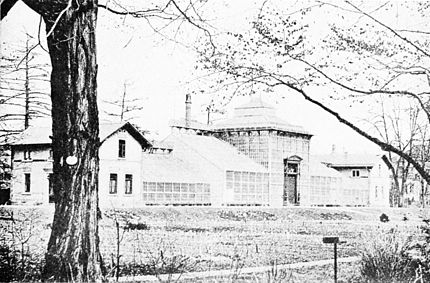thence to the University of Berlin, where he vigorously continues his researches. In consequence of his short stay but little of his work was accomplished at Tübingen.
The direction of the institute and garden was assumed by Prof. Wilhelm Pfeffer in 1878, who remained in the place nine years. The splendid results accomplished by himself and students during that time are published in a set of two volumes entitled Untersuchungen aus den botanische Institut zu Tübingen. The work dealt with the principal problems of physiology in growth, turgescence, secretion, movements, respiration, and nutrition. In 1887 Pfeffer removed to Leipsic. Both before and after his stay

View of Palm Houses, Work Rooms, and Herbarium, in Autumn. After a photolithograph in "Die unter der Regierung seiner Majestät des Königs Karl an der Universität Tübingen errichteten und erweiterten Institut der naturwissenschaftlichen und der medizinischen Fakultät," 1889. By permission.
at Tübingen he made most important contributions to the science, especially with regard to the physical and chemical properties of plant tissues, notably in osmosis and turgidity, and also in the transformations of energy within the organism. His laboratories and lecture room are thronged with students from all over the world, many of whom are Americans.
The present director of the institute and garden, Prof. Hermann Vöchting, succeeded Pfeffer in 1887. Prof. Vöchting may be said to be to some extent a representative of the modern idealistic school with which Braun, his old teacher, was identified. His work, however, resembles that of the idealists only so far as to exhibit the immense value of comprehensive discussions of the results of careful inductive inquiry, not only in the establishment
